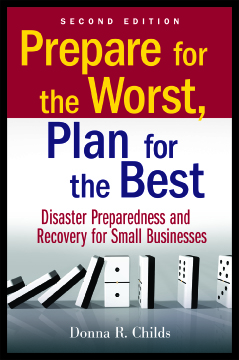According to Equifax, the rate of bankruptcy filings among small businesses is skyrocketing; on average, 350 new filings per day, an increase of 52% as compared with the previous year. Part of the problem is the trickle down effect, as when large corporations such as General Motors file for bankruptcy, they cancel contracts and discharge debts they owe to their suppliers. The 2005 revisions to bankruptcy laws are much tougher on small businesses than on larger corporations, which are often the genesis of the small business’ financial difficulties! Even worse, in today’s tough economy, even those corporations that are going concerns are often in arrears in paying their suppliers. According to the Equifax bankruptcy study, the largest run-up in bankruptcy filings is driven by the transportation industry, which includes the troubled automobile and airlines businesses. The transportation industry is followed by the construction, manufacturing and retail industries. The stress can be seen in local trends, with small business bankruptcy filings increasing the most in Los Angeles and Chicago. Local unemployment is a major contributor to small business bankruptcies. Lack of access to credit appears to be accelerating the trend, as small businesses can no longer borrow working capital until times improve. Small businesses that supply discretionary services, such as restaurants, child-care facilities and entertainment, are at particular risk as consumers cut back such expenses in a recession. Rising prices, particularly in core commodities, such as gas and food, are contributing to the problem. And fewer people are starting new small businesses to replace the failed ones. For small businesses that see no way forward, a Chapter 7 bankruptcy allows for an orderly liquidation and discharge of debt. If it is possible to reorganize the business or sell it as a going concern, Chapter 11 may be the better option. These are tough times, indeed.
Archive for July, 2009
Small Business Bankruptcy Filings Surge
Thursday, July 9th, 2009California Budget Crisis Update
Wednesday, July 8th, 2009Further to an earlier blog posting on the topic of California’s decision to pay certain of its contractors in scrip, the State Legislature is considering a bill that would require the State to accept its own paper as payment for taxes, fees and other obligation due. After all, it is only fair that California accept its own currency. Irrespective of what happens with this bill, small business owners should use the IOUs as payments towards California state taxes, city taxes, fees, and other government obligations. If I were a California small business owner, I would even use the IOUs to pay the IRS. After all, the federal government is in a better position to collect from California than I am. This should dampen the pain for the businesses that are put in a terrible cash flow position with this move. Check cashing companies have indicated that they will accept the IOUs, but they charge onerous fees. Better to redeem the notes pack to the state to retire other obligations and conserve cash.
Paperback Edition on Its Way
Wednesday, July 8th, 2009 Later this month, John Wiley & Sons, Inc. will publish the paperback version of the second edition of Prepare for the Worst, Plan for the Best: Disaster Preparedness and Recovery for Small Businesses. The list price will be $24.95, but most major retailers typically discount 30% off of list prices, bringing the price of the book down to the $16 – $17 range. This will make the book more affordable to a broader audience, so I am very pleased about that. I also love the new cover; the image of falling dominoes originally appeared on this site, on the first link to the home page. I look forward to meeting as many readers as possible when the new book comes out and am preparing to update my calendar and this site for that happy event.
Later this month, John Wiley & Sons, Inc. will publish the paperback version of the second edition of Prepare for the Worst, Plan for the Best: Disaster Preparedness and Recovery for Small Businesses. The list price will be $24.95, but most major retailers typically discount 30% off of list prices, bringing the price of the book down to the $16 – $17 range. This will make the book more affordable to a broader audience, so I am very pleased about that. I also love the new cover; the image of falling dominoes originally appeared on this site, on the first link to the home page. I look forward to meeting as many readers as possible when the new book comes out and am preparing to update my calendar and this site for that happy event.
This paperback version represents the second edition, which is newly updated with 40% new content from when the book was originally published. At that time, we were early in our own disaster recovery process and still held out the hope that promises made by the federal, state and city governments would materialize. Having now worked through the complete recovery process, and seeing how those “aid” programs worked out, I can share that information with small business owners across the country. I think that this is particularly important as you have very little margin for error in recovering from a disaster. We have seen the same themes, time and time again, from what happened to small businesses in the aftermath of Hurricane Andrew in Florida in 1992 to, more recently, what happened to small businesses in the aftermath of Hurricanes Gustav and Ike and the Iowa floods. There should be more national learning taking place, and I think that this might be a unique contribution to help other small businesses that find themselves in this difficult position. It can be comforting to know that you are not alone, that others have worked through this process and what worked and what failed.
SBA Modifies 504 Loan Program
Tuesday, July 7th, 2009Last week, the Small Business Administration permanently changed its 504 loan program so that businesses can refinance to expand or buy equipment. In the past, the 504 program provided new loans to buy real estate, upgrade machinery and make other capital improvements. Now the program provides for refinancing of any fixed-asset loan as long as the amount is 50% or less than the total cost of expansion. The redesign is intended to help small businesses restructure their debt under better terms to improve their cash flow positions. However, the small business must also create or retain a job for every $65,000 guaranteed by the SBA, an increase from the previous requirement of $50,000. Unfortunately, this modification will not help those of us whose small businesses were prudent and refrained from taking on debt. This is only helpful for those who need to refinance. Moreover, it is a dicey proposition for any small business to take on additional debt, or guarantee employment at this time, given the uncertainty about the economy. The SBA expects to announce next week a new loan program to assist car dealers in purchasing inventory. It just seems that the SBA is out of synch with what is going on in the economy at the moment. For service businesses, that constitute the bulk of employment, we don’t typically have major capital investments in equipment, but we certainly have working capital and cash flow pressures. They don’t seem to have anything for us.
California Small Businesses Paid in Scrip
Tuesday, July 7th, 2009Just when you thought it was hard enough with lack of access to bank loans, some small businesses in California that contract with the state are being paid for their services in IOUs instead of liquid funds. Owing to a $26.3 billion budget deficit, and the apparent inability of lawmakers to agree to spending cuts or tax hikes, the state does not have sufficient cash to cover all of its payments. I have spoken with small business owners in California that contract to provide goods and services to the state and cash flow pressures in the summer months are nothing new. The California Legislature has rarely met its own June 30 budget deadline, with the result that the state is often in arrears in making scheduled payments to contractors over the summer months. However, this is the first time since 1992 that California has printed IOUs against certain of its obligations. State Controller John Chiang has stated that he will issue $3.3 billion in IOUs along with $11 billion in regular cash payments. Remember, California is the world’s eighth largest economy.
California’s cash flow problems may be disproportionately shouldered by small businesses. When California last issued IOUs for payments, state employees litigated their claims that receiving their paychecks in scrip constituted a violation of the Fair Labor Standards Act. A federal judge agreed, and the workers received their cash payments plus extra vacation time. So state employees will not receive IOUs for their paychecks this time. And, because the federal government is paying certain of California’s social service obligations to the elderly and disabled, they will not be affected by the lack of cash. Governor Schwarzenegger reached out to financial institutions to urge them to accept the IOUs, called individual registered warrants, which will be redeemable by October at a 3.75% interest rate. Wells Fargo, Bank of America and Chase Bank have announced that they will accept the IOUs from existing customers through July 10. It is not clear what will happen after July 10 or what other institutions will do.
In Prepare for the Worst, Plan for the Best: Disaster Preparedness and Recovery for Small Businesses (Wiley, second edition, paperback, 2009), I presented a framework for which the California liquidity crisis would qualify as a third-party service failure. Small businesses that depend on clients, such as California, to make timely payments to fund their own obligations are at risk for failure to diversify their client base, just as you would with a vendor or service provider. I am sympathetic to the start-ups in that state, as the market there is brutal.
FDIC May Extend Coverage of Some Deposits
Monday, July 6th, 2009According to American Banker, the Federal Deposit Insurance Corp. may extend its blanket coverage for noninterest deposits, currently scheduled to expire at year end. Business customers often keep checking account balances that exceed FDIC coverage limits on insured deposits in order to meet payroll and other large obligations. The FDIC provided this guarantee in the fourth quarter of 2008 as the financial crisis deteriorated. The FDIC is said to be concerned that if it fails to provide assurances that it intends to extend the program, business customers might begin to withdraw funds and split accounts across a number of insured banks, creating some unnecessary uncertainty in the banking and business systems. Small businesses that have accounts exceeding FDIC coverage requirements should watch the FDIC website for developments in this matter to ensure that their deposits remain within coverage limits.
Recovery and Reinvestment Tax Benefits
Sunday, July 5th, 2009While the emergency loan program legislated into effect by the stimulus bill may have limited benefits for small business owners, there are other provisions to encourage capital investment that are worth considering. The American Recovery and Reinvestment Act provides certain incentives, for a very brief time frame, for small businesses considering capital investment:
- Faster recovery of certain investments in business property. If your small business invests in new property or equipment in 2009, there are two means to increase deductions related to those capital expenditures:
- Increased limit on Section 179 expense. You may expense, rather than depreciate, the cost of machinery, equipment, vehicles and other tangible property placed in service in 2009, up to a maximum deduction of $250,000. The cost of property in excess of $250,000 may be depreciated over its life. In 2010, the Section 179 cap will drop from $250,000 to $133,000 (indexed for inflation). After 2010, the cap returns to the prior limit of $25,000. The Section 179 deduction cannot exceed taxable income, but it may be carried over to future years. However, it phases out for capital expenditures above $800,000 and limits the tax break to smaller businesses.
- Bonus depreciation allowed in 2009. You may deduct up to 50% of the cost of “qualified property” (defined as almost any capital expenditure other than buildings) purchased and placed in service in 2009. You may take the benefit of both the Section 179 expense and the bonus depreciation. However, the basis for depreciating the property must first be reduced by the Section 179 expense.
- Extended net operating loss (NOL) carry-back period. Typically, a net operating loss may be carried back two years and forward twenty years to offset taxable income. For NOLs created after Dec. 31, 2007, the Recovery and Reinvestment Act provides a five-year carry-back period. So if your business paid taxes in the prior five years, the NOL may be carried back to the fifth prior year and each succeeding year to offset income and refund taxes. This benefit is available provided that your business gross income did not average more than $15 million in the three years leading up to the NOL. To claim the refund, eligible businesses must file Form 1139 by Sept. 15. Eligible individuals must file by Oct. 15 using Form 1045.
- Shortened period for taxing S corporation built-in gains. Corporations which elect S corporation status are not taxed at the corporate level. Instead, the income, deductions and credits are reported by the owners. If a C corporation elects S corporation status, any gain inherent in property owned by the corporation at the time of the election and sold within 10 years of the election will be taxed at the maximum corporate rate (currently 35%). The Recovery and Reinvestment reduces the 10-year period to seven years in 2009 and 2010. This will benefit corporations that became S corporations (or acquired property from a C corporation) between 1999 and 2003. How Congress thinks a backward-looking adjustment will motivate forward-looking investment is beyond me, but I guess the lobbyists have been busy.
- Benefits for small business owners. You may exclude 75% of the gain from qualified small-business stock acquired after Feb. 17 of this year and before Jan. 1, 2011. To qualify, the stock must be held at least five years and acquired at the original issue date. This provision will benefit individuals after Feb. 17, 2014, upon satisfying the five-year holding period. Certain limitations apply to the exclusion, which is normally 50% of the gain. In addition, if you receive more than 50% of your income from a small business, the required 2009 estimated tax payments are lowered. Normally, estimated tax payments must equal or exceed the lesser of 90% of the current year tax or 110% of the prior-year tax obligation. In 2009, taxpayers who qualify only make estimated payments based on the lesser of 90% of the 2008 tax or 90% of the 2009 tax. This provision benefits taxpayers with 2009 income greater than 2008.
One caveat: I am not an accountant, so print out this entry and discuss this information with your accountant to get the advice that is specific to your unique situation.
Unbelievable!
Sunday, July 5th, 2009The image shown here is that of the home page for the Intranet I had built for Childs Capital LLC. I did all of the work using the products of Adobe Creative Suite (which includes Photoshop, InDesign, Illustrator and Acrobat). Adobe is one of my favorite companies; I absolutely love its products. So I was stunned to read that it had shut down its North American operations this week as part of a corporate-wide plan to reduce operating costs. Adobe, the world’s largest maker of graphic design software, announced to employees back in March that, in addition to the normal holiday shutdown between Christmas and New Year’s Day, the company would close for one week in the second, third and fourth quarters. Staff were asked to take paid vacation time. This measure is on top of an 8% reduction in the workforce taken last December and salary freezes and bonus reductions imposed on the remaining employees. The company has reduced variable compensation plans and cut travel costs. Spending on information technology is falling as recessionary pressures force companies to cut spending. Adobe is not immune from these pressures, as its second quarter sales declined 21% as customers postponed upgrading to the latest version of Creative Suite.
I also happened to read the newspapers reports that Crabtree & Evelyn Ltd. has filed for bankruptcy. The company expects a 24% decline in sales from last year and projects a 30% decline in wholesale sales this year. When I was a high school student, Crabtree & Evelyn personal care products were a favorite of the girls who were my classmates. I never thought I would see the day that companies that make such great products would be in such distress.







